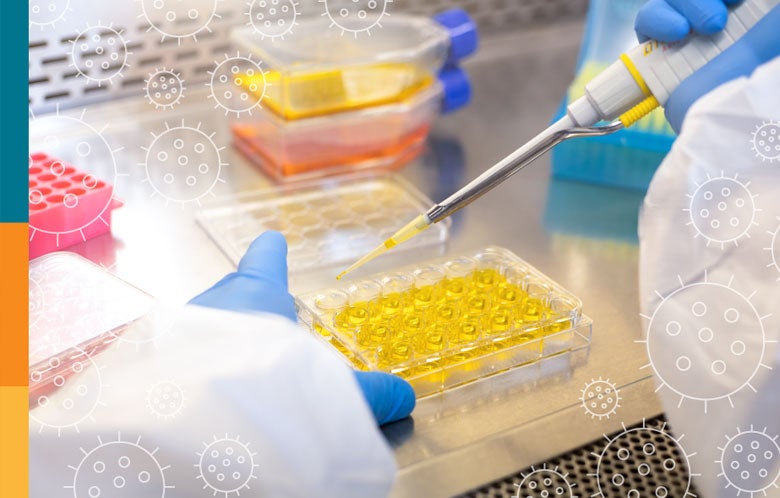Vaccine development is commonly a long, arduous process. In the middle of the COVID-19 pandemic, however, the world needs a SARS-CoV-2 vaccine now.
The first step in vaccine design is identifying the vaccine target, or “antigen of interest” from the pathogen. The surface of SARS-CoV-2 is surrounded by spike proteins which allow it to enter human cells via interaction with the ACE2 receptor. Fortunately, we know from past research on SARS-CoV-1 and MERS-CoV that the spike protein on SARS-CoV-2 is likely an ideal vaccine target. In order to generate immunity for SARS-CoV-2, a vaccine should induce a robust and well-rounded immune response to the spike protein including T cells and neutralizing (not just binding) antibodies that will subsequently prevent SARS-CoV-2 from infecting human cells.
There are multiple platforms for delivery of the spike protein to host immune cells (i.e. antigen presenting cells) that initiate immunity to SARS-CoV-2. Whole pathogen vaccines, (attenuated or inactivated) subunit vaccines, nucleic acid vaccines and viral vector vaccines are all possible options for a SARS-CoV-2 vaccine, each with their own unique advantages and disadvantages.
- Whole pathogen vaccines consist of entire pathogens that have been attenuated (weakened) or inactivated (killed) so that they can no longer cause disease.
- Creating a live-attenuated vaccine requires introduction of live virus into a different host (an animal, tissue culture, or embryonated egg) so that it can accumulate mutations which allow it to thrive in its new host. This results in a virus better adapted to the new host and no longer harmful to the original host (the human or vaccination target). This process, however, takes time. Although live vaccines produce a strong immune response, another drawback is that they are commonly contraindicated in immunocompromised and pregnant individuals.
- Inactivated (killed) viral vaccines involve killing the virus via chemical, heat, or radiation and requires handling large amounts of infectious material. Maintaining the integrity of the spike protein would be critical in order to create an effective but also safe vaccine, and the processes by which the virus is inactivated can make that tricky.
- Subunit vaccines differ from whole pathogen vaccines in that they exclusively deliver the antigen of interest (the spike protein) instead of the entire pathogen to host immune cells in order to stimulate immunity. They are often poorly immunogenic, so require an adjuvant which may limit global production capacity.
- Nucleic acid vaccines are similar to subunit vaccines in that they exclusively deliver the antigen of interest but do so by delivering the genetic material which encodes for it. The body’s own cells then use this genetic material — DNA carried in a plasmid, RNA carried in a lipid nanoparticle, or either nucleic acid carried in a benign virus — to give rise to the antigen of interest.
- DNA and RNA vaccines are easy to scale up and neither would require handling infectious material. We have yet to develop DNA or RNA vaccines approved for use in humans however, which means entirely new infrastructure to manufacture and distribute them is necessary. DNA vaccines also have the potential for mutagenicity, a risk which is avoided with RNA vaccines.
- Viral vector vaccines carry genetic material into human cells by way of a benign virus. This is the only nucleic acid vaccine for which we have an existing human vaccine (ERVEBO, a viral vector vaccine for Ebola). In developing a viral vector vaccine, it is important to consider any existing immunity to the viral vector which could blunt the vaccine’s effectiveness.
Once a candidate vaccine is engineered, it must go through several trials before it is approved for public use. Candidate vaccines are initially tested on animals in preclinical trials and involve evaluating safety, immunogenicity and efficacy. Following preclinical trials, a candidate vaccine may receive approval for human testing, starting with phase I trials. Phase I trials evaluate safety, reactogenicity (typical vaccine side effects like injection-site pain, redness, fever) immunogenicity, schedule and dosing in a small group of healthy participants. Phase II trials are scaled-up version of phase I trials and include some of the target population. Vaccine efficacy is finally evaluated during phase III trials. If a new vaccine receives FDA approval, it moves on to Phase IV trials which assess long term safety and effectiveness.
Typically, each of these steps can take months, if not years and follow each other sequentially. On average, preclinical and clinical trials together take 15-20 years. Fortunately, and for multiple reasons, when it comes to SARS-CoV-2 this timeline has been significantly accelerated. Here’s why — first, we have a lot of data from SARS-COV-1 and MERS-CoV to work from. We also have the whole world working towards the same goal; according to the World Health Organization (WHO) as of the end of June, there are 141 vaccine candidates with 16 already in clinical trials. Preclinical and clinical trials have also started to overlap which is compressing the timeline. There are also lots of willing volunteers and fast-tracked federal approvals which make estimates for a vaccine by mid-2021 (instead of 2035 under normal circumstances) more attainable.
Despite such fervor in development, there are significant challenges and potential risks going forward. Ironically, it may be difficult to show that a candidate vaccine is effective in phase III trials if social distancing or other mechanisms to decrease spread (masks, hand washing) slow the rate of new infections. One way to get around this is to choose participants for phase III trials that are already at an increased risk of getting infected with SARS-COV-2, such has healthcare workers, persons living in congregate settings or essential workers in close contact settings like factories. Another more ethically questionable option is to conduct Human Challenge Trials in which participants are inoculated with the candidate vaccine and then deliberately exposed to SARS-CoV-2.
Human Challenge Trials aside, there is also a potential risk for antibody dependent enhancement as a result of the candidate vaccine. This is a phenomenon in which binding of virus to non-neutralizing or binding antibodies can enhance viral entry into cells and lead to increased infectivity and virulence. This is one reason why maintaining the integrity of the spike protein when creating a vaccine candidate for SARS-CoV-2 is so important — because an alteration in the spike protein could ultimately lead to binding instead of neutralizing antibodies.
Typically manufacturing begins after clinical trials have concluded. Several groups like the Coalition for Epidemic Preparedness Innovations (CEPI) and the Advanced Research and Development Authority (BARDA) however, are making upfront investments in manufacturing in anticipation of a vaccine for SARS-COV-2. And ultimately investment will drive distribution. To counter this, the WHO launched a global initiative to ensure equitable access to a vaccine worldwide and groups (like CEPI) and countries all over the world have pledged their support.
Realistically, to meet global demand, we are going to need more than one vaccine. Having more than one vaccine available will help avoid bottlenecks in manufacturing and some vaccines may be more effective in certain populations. Despite the obstacles, given the progress made in just six months from the first documented cases of SARS-CoV-2, there is certainly room for hope for a safe and effective SARS-CoV-2 vaccine in the future.



